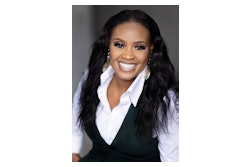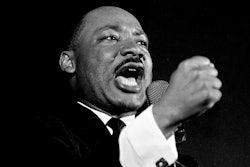A Passion for Cuba
University of Connecticut music professor explores African roots in the island nation Dr. Robert Stephens, professor of music at the University of Connecticut-Storrs and interim director of the school’s Institute for African American Studies, says he has always had a passion for Cuba. That passion — indulged to the fullest in his four years of leading scholarly excursions to the island nation — seems to leap off the pages of Stephens’ scrapbooks of Cuban memorabilia.
Glorious shots of the verdant Cuban countryside alternate with graceful, old Spanish cityscapes from Havana. An elderly musician with nut brown skin and an infectious smile raises his beer bottle in salute in an urban bar. Street painters hawk their wares, as bands enthrall the tourists. Women wearing the colors of the goddesses strut their stuff on the streets of Santiago de Cuba during carnival. Bare-chested men pound the bata and iya drums during ceremonies whose roots drink deeply from the religions of Africa. And there are pages upon pages of faces — both old and young, poverty-stricken and well-to-do, some with the light skin and dark hair that one associates with Miami Cubans, but most with a range of hair texture and skin tone more reminiscent of South Central Los Angeles, or some other all-Black American enclave.
Most Americans don’t realize, Stephens says, that “slavery didn’t really end in Cuba until the 1880s. So connections between Africa and the island — particularly, as regards my area of interest, the Yoruba — are still very evident.”
Indeed, not only are they evident, they’re also embraced. Stephens, who minored in ethnomusicology while getting his doctorate in music education at Indiana University, explains that his primary research interest is in the music associated with Lucumi, an African-based religion that many in the United States call Santeria. The Communist regime, while initially hostile to all religions, has become strongly supportive of such research.
“Essentially what has happened since the collapse of the Soviet Union — what’s called Cuba’s ‘special period’— is that all the things that were formerly marginalized have gone mainstream,” he says, and that includes African-based religious practices. Indeed, folk dance groups stage secular versions of African-based religious ceremonies for tourists — a practice that is hotly debated in Cuba, Stephens says. And all the larger cities now have Casas de las Religiones —”houses of the religions” — that maintain active shrines for the three main African-based religions: Lucumi, Palo Monte and Spiritualism.
These casas are open to practitioners, who may check ritual objects out and return them when ceremonies are concluded, and they also welcome scholars. Scholars are, in fact, venerated, particularly those whose work probes the African roots of Cuban culture.
And the work of those scholars is greatly facilitated by the existence, primarily in Cuba’s urban centers, of “cabildos.”
“We have no such thing in the United States,” says Stephens, explaining that cabildos are “nation houses”— houses associated with the various language groups that the slave trade brought to Cuba. For example, there are cabildos for people whose roots lie in the Congo region (of Africa); others for people whose ancestors were Yoruba from present-day Nigeria. One of the cabildos Stephens’ group visits was founded in the 1820s — and is still maintained by the same family.
The situation stands in sharp contrast to conditions in the United States, where, due to the hostility of Protestant religions, “all things African were absolutely abhorred,” explains Stephens. “There were laws passed that actually banned the use of certain African instruments, particularly the drums.”
And this had a profound effect on the development of African American music and on the retention of the religious practices with which that music was inextricably bound. “African American-based music is not nearly as rhythmic as music in the Caribbean, particularly Cuba,” Stephens notes. Exploring Afro-Cuban Culture
The group of 17 that Stephens took to Cuba last month included both scholars and students. “We structure things around Afro-Cuban culture,” Stephens says, with visits to cabildos, a 19th-century botanica, to Santiago de Cuba’s carnival, as well as visits with scholars, students and musicians.
“But we also try to leave things open so people can explore areas of interest to them,” he adds. “There’s a couple going down — the wife is in public health and has an interest in the religious use of herbs, so we’re going to connect her with people who can tell her about that.
Her husband, though, is interested in systems of government, and he’ll be looking at the way in which the government has helped sustain Afro-Cuban culture. There’s another colleague who’s interested in rap, so he’ll be investigating the rise of rap and talking to musicians.”
The group will be traveling all over the island, to Matanzas, “a Black city where basically everyone looks like me and you,” explains Stephens, noting that 67 percent of Cuba’s population is estimated to be of African descent; to Santiago de Cuba, at the southernmost tip of the island, which due to its proximity to Haiti is a center for French Caribbean culture, including vodun; and to Havana, with its pure Castilian Spanish influences and architecture.
Along the way, the members of the group will be conducting interviews, collecting chants, videotaping ceremonies — and otherwise doing the work that supports scholarly publications. Stephens, meanwhile, says he’s particularly looking forward to meeting and perhaps interviewing Lázaro Ros y Olorun, perhaps the most famous religious singer in all of Cuba.
The trips are valuable from an institutional standpoint — advancing the body of knowledge and raising the university’s public profile through conferences and publications. But the greatest benefits, Stephens says, are a bit more intangible — and much more personal.
“I grew up in Savannah, Georgia,” he explains. “And I remember parents and teachers being so careful to instill in us that we were not to have anything to do with certain things”— like Geechee speech patterns and the mysteriously named “roots.”
Geechee, or Gullah is both a creole language — containing elements from many different African languages as well as English — and a culture of foodways, folktales and folk song, as well as crafts, herbal medicine and religious practices associated with the South Carolina and Georgia coastal region, whose ports were those through which an overwhelming majority of African slaves entered the United States.
It wasn’t until he got to graduate school that he learned that what he called “Geechee” was called “Gullah” by scholars and was, in fact, a serious subject of scholarly investigation. Stephens’ work investigating African retentions in Cuban culture is deeply connected to that moment of discovery in graduate school.
“It’s a positive affirmation to a part of me that’s not fully actualized, but that I know is there: My connection to my Africanness — things we believe, values we hold, institutions we support as well as more intangible things like our behavior, gestures, how we interact, what is considered acceptable or unacceptable.
“All these are things that we can glean through studying creative and expressive acts, cultural artifacts, music.”
© Copyright 2005 by DiverseEducation.com


















